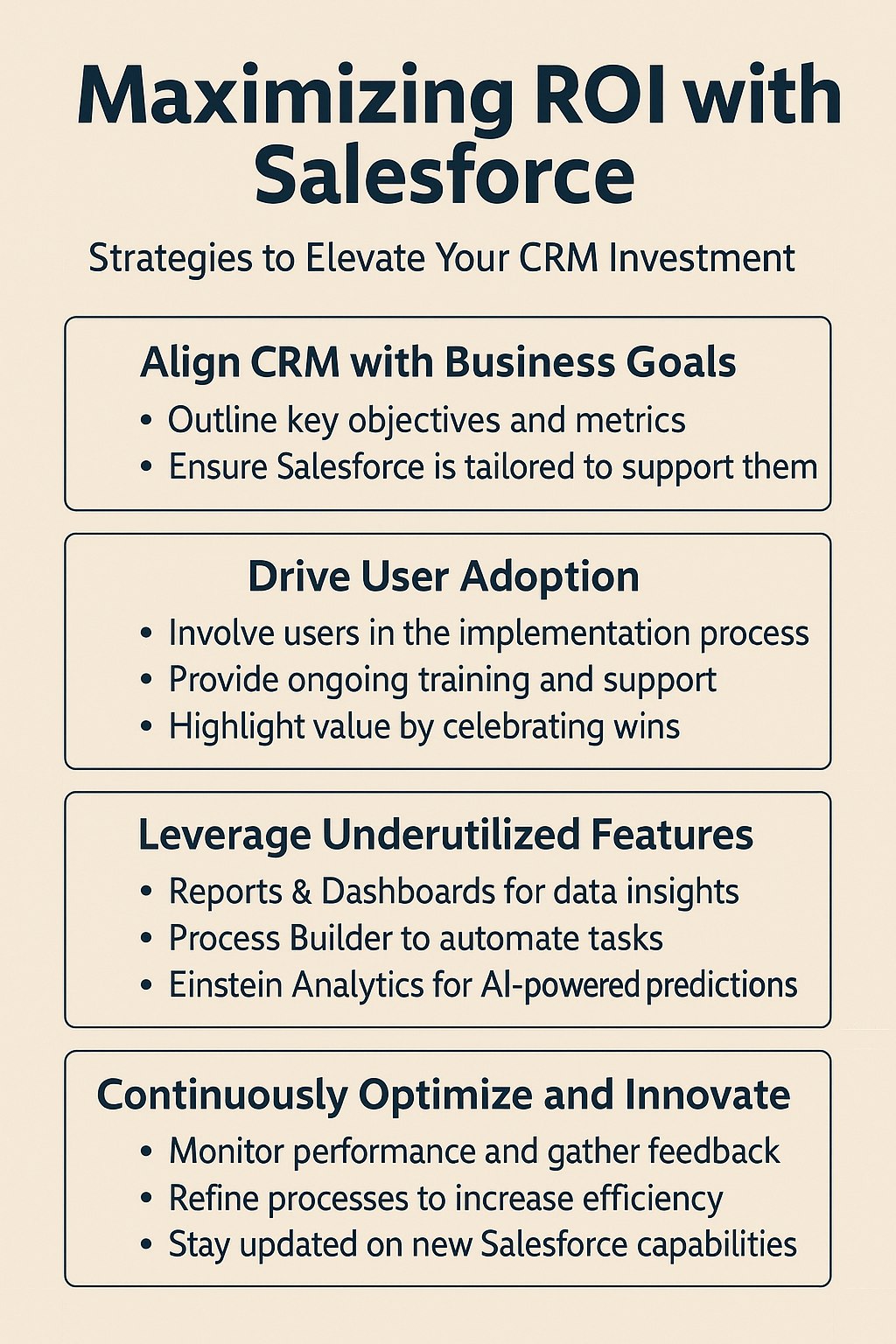Maximizing ROI with Salesforce: Strategies to Elevate Your CRM Investment
Salesforce isn't just a CRM—it's a platform that, when used strategically, can transform your organization. But simply purchasing licenses isn't enough. The real value lies in how effectively you use it to support growth, efficiency, and customer satisfaction. In this article, we’ll explore key strategies to help you maximize your return on investment (ROI) with Salesforce.
1. Align Salesforce with Business Goals
Why it matters:
Your Salesforce setup should reflect your unique business strategy. If your CRM processes don't align with how your teams operate or how your customers engage, you’re leaving ROI on the table.
What to do:
- Define clear success metrics tied to revenue growth, customer retention, or productivity.
- Configure objects, processes, and dashboards to reflect your business KPIs.
- Revisit and realign these metrics regularly as your business evolves.
2. Focus on User Adoption and Experience
Why it matters:
A system only delivers ROI when people use it effectively. Poor adoption is one of the top reasons Salesforce fails to deliver its full value.
What to do:
- Create role-based page layouts and permission sets to streamline the interface.
- Invest in initial and ongoing training for users.
- Collect feedback often to fine-tune user experience.
3. Automate Where It Counts
Why it matters:
Time is money. Repetitive tasks drain productivity and increase the chance of human error.
What to do:
- Use Flows and Process Builder to automate lead assignment, approval processes, and customer follow-ups.
- Employ Einstein Bots or automated email journeys for enhanced customer engagement.
- Prioritize automation of processes that directly impact customer satisfaction or revenue.
4. Use Reports & Dashboards to Drive Decisions
Why it matters:
Salesforce offers robust analytics capabilities. If you’re not using them to drive strategy, you’re missing key insights.
What to do:
- Set up dashboards for sales, marketing, and service leaders with real-time data.
- Use custom report types to track performance against goals.
- Implement Einstein Analytics for predictive and visual storytelling.
5. Leverage Underutilized Features
Why it matters:
Many businesses stick to basic Salesforce features and never unlock the full value of their licenses.
What to do:
- Explore features like Salesforce Inbox, Salesforce Maps, and Knowledge Base.
- Evaluate AppExchange tools to solve specific business challenges.
- Consider add-ons like CPQ, Field Service Lightning, or Marketing Cloud if applicable.
6. Keep It Clean and Scalable
Why it matters:
Over time, unused fields, outdated automation, and duplicated records can hinder performance.
What to do:
- Conduct quarterly audits of fields, workflows, and user roles.
- Use Data Loader or third-party tools to clean and de-duplicate records.
- Implement scalable practices from the start to reduce technical debt.
7. Measure and Optimize Continuously
Why it matters:
You can’t improve what you don’t measure. ROI should be tracked and improved iteratively.
What to do:
- Track key metrics like sales cycle length, support case resolution time, and system usage.
- Run regular health checks and business reviews.
- Adjust processes and configurations based on analytics.
Conclusion
Salesforce can be your most powerful asset when fully leveraged. It’s not just a software solution; it’s a living, evolving system that must be aligned with your strategy, embraced by your team, and fine-tuned over time. By applying these strategies, you’ll maximize the return on your investment and position your business for long-term success.
